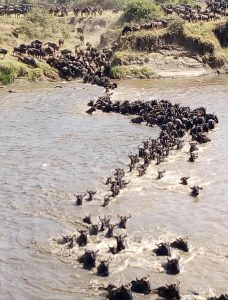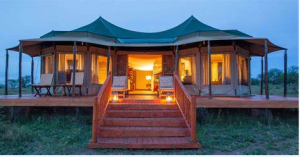The Annual Wildebeest Migration – Nature’s Greatest Spectacle
The Great Wildebeest Migration is one of the most awe-inspiring natural events on Earth, attracting wildlife enthusiasts from around the world to witness this incredible journey across the plains of Tanzania and Kenya. This epic migration, often called “The Greatest Show on Earth,” involves over 1.5 million wildebeests, along with thousands of zebras and gazelles, making their way across the Serengeti ecosystem in search of fresh grazing lands and water.

The migration is a year-round cycle, with each season offering unique scenes. In Tanzania, the spectacle usually begins in the southern Serengeti during the rainy season from December to March. Here, in the lush Ndutu region, the wildebeests gather in large numbers for calving season, when thousands of newborns are introduced to the world. This time is especially remarkable for witnessing predator-prey interactions, as lions, cheetahs, and hyenas take advantage of the abundance of young calves.
From May to July, as the dry season approaches, the herds begin their northward journey across the Serengeti plains, facing numerous challenges along the way, including crossing the Grumeti and Mara Rivers. These river crossings are the most dramatic and intense moments of the migration, where wildebeests and zebras brave strong currents and lurking crocodiles to reach greener pastures on the other side. This stage of the journey provides unforgettable sights and sounds, epitomizing the survival instincts of these remarkable animals.
 By October, the herds begin their journey back south to Tanzania, traversing the vast plains of the Serengeti as they complete the migration cycle and prepare to start anew. This movement marks a time of gathering and anticipation, as the animals instinctively follow the rains and fresh grazing grounds. The Great Migration is not only a phenomenal wildlife event but also an experience that highlights the resilience and interconnectedness of Tanzania’s ecosystems, where every landscape and creature plays a crucial role in this natural rhythm.
By October, the herds begin their journey back south to Tanzania, traversing the vast plains of the Serengeti as they complete the migration cycle and prepare to start anew. This movement marks a time of gathering and anticipation, as the animals instinctively follow the rains and fresh grazing grounds. The Great Migration is not only a phenomenal wildlife event but also an experience that highlights the resilience and interconnectedness of Tanzania’s ecosystems, where every landscape and creature plays a crucial role in this natural rhythm.
For visitors, witnessing this migration is an unparalleled opportunity to see one of the most powerful natural spectacles on Earth. This ancient journey across the Serengeti is a testament to the survival instincts of millions of animals and a symbol of Tanzania’s commitment to preserving its rich wildlife heritage for generations to come.
Migration Safaris in Tanzania and Kenya
From July onwards, the wildebeest continue their northward journey, eventually crossing into Kenya, where they arrive at the iconic Masai Mara National Reserve.
After exploring the Serengeti, you’ll stop at a tranquil spot along Lake Victoria, where you can embark on a traditional canoe trip and observe local fishermen at work. From there, you’ll travel to the Masai Mara National Reserve, where you’ll have the opportunity to spend dedicated time tracking the wildebeest as they continue their journey through this spectacular park.
While in the Masai Mara, you’ll also enjoy exceptional wildlife viewing, with opportunities to spot lions, elephants, buffalo, leopards, and more. After several unforgettable days, you’ll drive to Nairobi to conclude your adventure or return to Arusha. A cross-border migration safari through both Tanzania and Kenya offers the ultimate chance to witness a river crossing and experience the Great Migration in all its awe-inspiring glory.
 What to Expect on Serengeti Migration Safaris
What to Expect on Serengeti Migration Safaris
A Serengeti migration safari offers a once-in-a-lifetime experience, allowing you to witness one of nature’s most remarkable spectacles: the Great Wildebeest Migration. Here’s what you can expect when embarking on a migration safari in the Serengeti:
1. The Thrill of the Migration
Depending on the time of year, you’ll be able to witness the wildebeest, zebras, and gazelles moving in massive herds across the Serengeti. The migration is a dynamic event, with the animals following a natural cycle driven by the search for food and water, which creates incredible opportunities for wildlife viewing.
- Calving Season (January to March): Visit the Serengeti during the calving season, and you’ll witness the incredible spectacle of thousands of wildebeest giving birth. This period also draws in predators, creating dramatic predator-prey interactions.
- River Crossings (July to September): The wildebeest must cross the crocodile-infested Mara River as they journey into Kenya’s Masai Mara. The river crossings are an iconic and intense highlight of the migration.
- The Return (October to December): As the herds begin their journey back south to the Serengeti, the landscape comes alive with their movement across the plains.
 2. Exceptional Wildlife Viewing
2. Exceptional Wildlife Viewing
The Serengeti is home to an impressive array of wildlife. While the migration is the main attraction, the park’s diverse ecosystems also allow you to encounter other iconic animals such as:
- Lions, leopards, and cheetahs: The predators of the Serengeti are a thrilling part of the migration experience, and game drives offer opportunities to see them in action.
- Elephants, giraffes, buffalo, and rhinos: These iconic species can be spotted in various parts of the Serengeti, often in close proximity to the migration.
- Birdlife: Serengeti is also home to a rich variety of birds, including vultures, storks, and migratory species, providing excellent birdwatching opportunities.
3. Incredible Scenery
The Serengeti’s vast, sweeping plains and dramatic landscapes provide stunning backdrops for the migration. From the golden savannah to the lush riverbanks, the scenery is ever-changing, offering spectacular photography opportunities. Whether you’re observing a herd of wildebeest at sunset or watching a lion stalk its prey in the morning light, the landscapes of the Serengeti are breathtaking.
 4. Game Drives and Safari Activities
4. Game Drives and Safari Activities
During your Serengeti migration safari, you’ll embark on daily game drives, led by experienced guides who will take you to prime locations to observe the herds and predators. Some additional activities to consider include:
- Hot air balloon safaris: For a unique and unforgettable perspective, take a hot air balloon ride over the Serengeti plains at sunrise.
- Walking safaris: In certain areas, you may have the opportunity to explore the Serengeti on foot, learning about the smaller wildlife and ecosystems.
- Cultural visits: Depending on your itinerary, you might also visit local Maasai villages to learn about their culture and way of life, adding a cultural element to your safari.
 5. Accommodation Options
5. Accommodation Options
Serengeti migration safaris offer a range of accommodation options to suit different budgets and preferences:
- Luxury lodges and tented camps: Many lodges and camps are strategically located near the migration routes, offering comfort and excellent views of the wildlife.
- Mobile camps: For a more immersive experience, mobile camps can be set up near the migration to ensure you’re close to the action.
- Budget campsites: For a more rustic experience, basic campsites are available in various parts of the park, often providing prime wildlife viewing opportunities.
6. Unpredictability and Flexibility
While the migration follows a general pattern, the exact movements of the herds can vary depending on rainfall and environmental conditions. This means that while your safari guide will take you to the best locations, there’s always an element of unpredictability in the experience, adding to the thrill of the safari. The flexibility of game drives allows you to follow the migration and adapt to the herd’s movements.
The Serengeti is vast, and having a knowledgeable guide is essential to maximizing your safari experience. Our expert guides will not only assist you in tracking the migration but also provide fascinating insights into animal behavior, the surrounding ecosystem, and the unique dynamics of the migration. With their expertise, they’ll enhance your chances of spotting elusive predators and hidden wildlife, ensuring you don’t miss any of the action.
8. Incredible Photo Opportunities
The Serengeti is a photographer’s dream, especially during the migration. Whether you’re capturing the dramatic river crossings, the hustle of thousands of wildebeest, or a lion’s stealthy approach to its prey, you’ll have endless opportunities to take stunning photos of wildlife in action. Be sure to bring a camera with a good zoom lens to capture distant animals.
9. A Unique Safari Experience
A Serengeti migration safari is one of the most unique and immersive wildlife experiences you can have. It’s not just about watching animals; it’s about witnessing a natural phenomenon that has been occurring for millions of years. The sheer scale of the migration, the drama of predator-prey interactions, and the vast landscapes combine to create an unforgettable adventure. Whether you’re a first-time visitor or a seasoned safari-goer, a Serengeti migration safari offers an unparalleled opportunity to connect with the wild in its most raw and dramatic form.
Join Us for This Unforgettable Experience Adventure!











